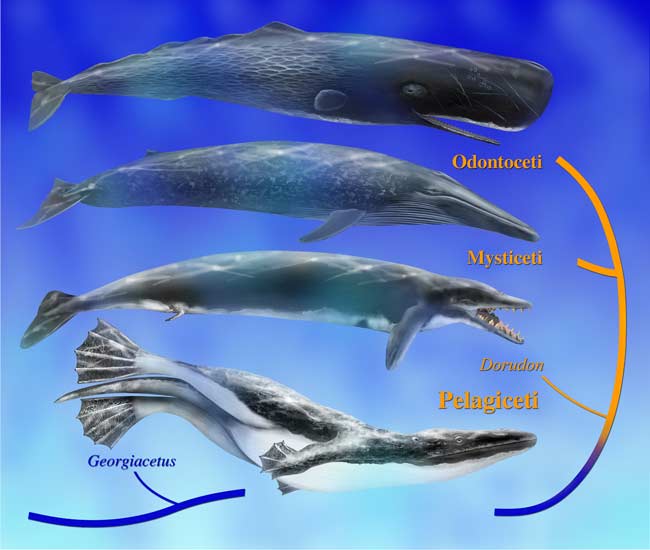Early Whales Had Legs

The first whales once swam the seas by wiggling large hind feet, research now suggests.
These new findings shed light on the mysterious shift these leviathans made away from land.
The ancestors of whales once strode on land on four legs, just as other mammals do. Over time, as they evolved to dwell in water, their front legs became flippers while they lost their back legs and hips, although modern whales all still retain traces of pelvises, and occasionally throwbacks are born with vestiges of hind limbs.
A great deal of mystery surrounds how the anatomy of the first whales changed to propel them through the water. A key piece of that puzzle would be the discovery of when exactly the wide flukes on their powerful tails arose.
"The origin of flukes is one of the last steps in the transition from land to sea," explained vertebrate paleontologist Mark Uhen of the Alabama Museum of Natural History in Tuscaloosa.
To shed light on this mystery, Uhen analyzed new fossils that amateur bone hunters discovered exposed along riverbanks in Alabama and Mississippi. These bones once belonged to the ancient whale Georgiacetus, which swam along the Gulf Coast of North America roughly 40 million years ago, back when Florida was mostly submerged underwater. This creature reached some 12 feet in length and likely used its sharp teeth to dine on squid and fish.
The first whales known to possess flukes are close relatives of Georgiacetus that date back to 38 million years ago. But while only about 2 million years separate Georgiacetus from these other whales, Uhen now finds that Georgiacetus apparently did not possess flukes. The new 2-inch-long tail vertebra he analyzed — one of some 20 tail vertebrae the ancient whale had — is not flattened as the vertebrae near whales flukes are.
Sign up for the Live Science daily newsletter now
Get the world’s most fascinating discoveries delivered straight to your inbox.
Instead, Uhen suggests that Georgiacetus wiggled large back feet like paddles in order to swim. Past research showed this ancient whale had large hips, which suggested it also had large hind legs. Oddly, scientists had also found that its pelvis was not attached to its spine. This meant its hind legs could not paddle in the water or support the whale's body weight on land, leaving it a puzzle as to what they were for until now.
"The idea we are now helping confirm is that this ancient whale wiggled its hips to swim, moving its feet like hydrofoils or paddles. So it swam rather like a modern whale, which undulates its body up and down," Uhen told LiveScience.
The scientists detailed their findings in the latest issue of the Journal of Vertebrate Paleontology.
- The Gay Gray Whale
- Useless Limbs Vestigal Organs
- World's Biggest Beasts










